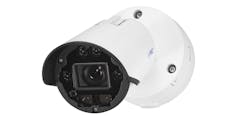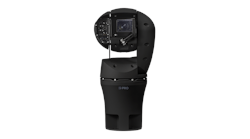For the purpose of conducting electricity, wire is most often a non-ferrous metal that has been drawn into varying thicknesses, usually circular in cross section. Electrically conducting wire is made of one or several combinations of non-ferrous metal(s). Gold is the most conductive metal, with silver coming close, followed for practical purposes by copper and tin. Gold and silver are expensive. As a result, copper has become the de facto base material for most electrical wire and cable.
There are two basic types of wire - single strand and stranded wire. Single strand (solid core) consists of one piece of non-ferrous metal wire of a specific diameter (gauge) within a jacket or insulation. Solid wire is less expensive to manufacture and provides greater protection against the elements. Single strand wire is normally installed in applications where there is no flexing.
Stranded wire is composed of smaller gauge wires combined (bundled) together to create a larger wire. Single strand wire is usually less expensive than stranded wire. The more strands, the more expensive the wire. However, the more strands, the more pliable the wire, and the less chance that breaking a strand will affect the current carrying capabilities.
The United States standardized wire using the American Wire Gauge (AWG) system. This standard, also known as Brown & Sharpe Wire Gauge, sets the cross sectional area of each gauge (diameter) of non-ferrous, solid, and round electrically conductive wire. The gauge determines the current carrying capacity of the wire.
For our purposes, the AWG uses sizes such as 10, 12, 14, 16, 18, 22, and 28 gauge. As a general rule, as the number size increases, the diameter of the wire decreases. For example, a 12 gauge wire is 0.0808” in diameter. An 18 gauge wire is 0.0403” in diameter. The 18 gauge wire is thinner, approximately half the diameter of the 12 gauge wire. This rule remains the same whether the wire is single strand or stranded.
Important: The greater the total thickness (gauge) of the wire, the more current gets carried because there is less electrical resistance over a given length. Thicker wire is required for longer wire runs than for shorter runs.
Stranded wire is recommended for access control applications. It is more flexible, and more resistant to breaking. Wiring for an access control system almost always involves bending and flexing in a retrofit application.
Stranded wire comes in the same gauges; the difference is there is more than one strand (conductor). Stranded wire of the same AWG is normally available with different numbers of strands. A good choice for access control installation would be 19 strands of 42 gauge conductors. The more strands, the greater the flexibility and forgiveness. More strands in a bundle translates into greater cost. However, a few extra dollars spent on wire can save hours of looking for a broken wire.
To simplify terminology, a wire is an individually insulated metal conductor (single cable). An electrical cable is one or more metal strands bound together. Electrical cables contain one or more conductors that can be individually insulated or bundled. Bundling the conductors can ensure a uniform bend radius across each conductor. The pulling and compressing forces can balance each another and provide the stability. As a result, a cable usually remains stable even under bending stress.
Basic cable types include twisted pair, coaxial cable, multi-core cable (consisting of more than one wire and is covered by cable jacket) and ribbon cable.
Twisted pair is a form of wiring where two wires are twisted together. Twisting wires together following a specific formula can be used to cancel out external sources of electromagnetic interference. This form of wiring works best on forward and return conductors of a single circuit.
Category 5 cable (Cat 5) is a twisted pair type cable having four pairs of twisted wires contained in a single jacket. Cat 5 is designed for high signal integrity on computer networks (Ethernet) and for voice services.
Locksmiths who install electro-mechanical standalone locks have connected ribbon cable. Ribbon cable is often used to connect the battery pack and the electronics on the interior side of the door with the reader mechanism on the exterior side of the door. Ribbon cable is flat, having a number of insulated conductors located side-by-side.
Wire used for access control applications are insulated using an outer layer of non-conductive material, commonly called an insulator. An insulator is a material that resists the flow of electric current. Insulating materials support and separate electrical conductors (wires) by keeping the current flowing through the wires and limiting or stopping the passing of current outside of the insulation.
Two basic types of wire insulation are the poly-vinyls (PVC) and Teflon®. Teflon is the better insulator. Teflon jacketed wires do not stretch as much when pulled with a reasonable amount of force. Excess pulling force will cause the Teflon to break. This eliminates breaking strands as the Teflon jacketed wire is pulled. Teflon is naturally slippery and Teflon jacketed wires slide through tight spaces easier than PVC. Teflon jacketed wires will not flame and do not put out toxins when melting. Teflon provides a better insulator than PVC. Most Teflon is also Plenum rated and can be used in above ceiling situations where an air plenum is included in the building construction.
Electricity is finicky. The larger the diameter of the wire, the more current that can flow through it. When electrical current flows through a copper wire, the current travels near the surface of the wire. Imperfections in the surface area of the wire can affect the flow. Raw copper has a tendency to pit, dent or divot, which affects the flow around the outside of the strand.
The flow of current is similar to the flow of a stream. Water has to flow around any obstacles, limiting the volume and the speed at which it is able to flow past the obstacle. This affects the amount of current available at the end of the wire run. The more obstacles, in wire, the slower and lower the current.
To compensate where necessary, wire is available with a coating (plating). The best conductive coating is gold, then silver, then tin. These metals are harder than copper and do not pit as easily. The secondary metal coating provides a case hardening, covering and sealing much of the surface imperfections. This improves the current carrying capability.
Magnetic Flux: As current flows through the wire, a magnetic flux field is created. The magnetic flux field is a pattern of circular field lines that surround the wire. The less expensive the insulator, the further out from the conductor the magnetic field can extend. The higher the current, the further out the magnetic field can extend.
A magnetic flux field can interfere with telephone lines and computer network cables. Do not run access control data wires near house current wiring as the 120VAC magnetic field produced can affect the data transmission.
To protect data transmission, use shielded cable or enclose the cable. Shielded cable has shielding along the length of the cable beneath the outer jacket. One end of the shielding is attached to an earth ground, providing absorption of the magnetic energy. Electrical current flows to ground. If tied at both ends to an earth ground, the shielding may under perform.
When the wire is stripped, the insulation must be cut almost completely through to the conductor. If the conductor is cut, this affects the flow of current.
A variety of wire strippers are designed to remove the insulation from electric wires. Manual wire strippers are similar to wire cutters with a center notch. area and pressure is applied carefully to cut into the insulation. Experience is needed to know when to stop applying pressure. A sharp wire stripper makes the task easier.
For those who do not have the expertise, purchase a good quality automatic wire stripper. Place the proper gauge wire into the automatic wire stripper and squeeze the handles together. The wire is stripped and the insulation is removed. Most hand-held automatic wire strippers only work on specific wire sizes or ranges of size. If a wire is not the proper gauge, the conductor may break or be damaged.
Connecting The Wires: Wires can be connected directly to a screw or compression terminal, soldered or crimped using a connector. Most alarm installers prefer to solder the wires together. A good soldered connection will not pull apart.
When soldering wires together, the exposed ends need to be insulated (covered) to prevent shorting. A better alternative than electrical tape is heat shrink tubing. Commonly known as “heat shrink”, this tube literally shrinks in diameter when heated. The starting diameter, length and thickness of heat shrink tubing vary and can be purchased for specific gauges of wire.
When using heat shrink tubing, place the tubing on the wire before the two conductors are soldered. Once soldered and cool, place the tubing over the connection, with overlapping excess on both sides of the connection of at least twice the diameter of the wire bundle being protected. For example, if your soldered connection is about 1/8 inch thick, you would want to extend the shrink over each end by at least 1/4 inch. Using the heat from a cigarette lighter, the heat shrink tubing shrinks onto the wire until it fits like a second skin protecting the connection.
The alternative to a soldered connection is a crimp connector. Crimp connectors come in different sizes, types and features.
Note: soldering or crimp connectors normally produce a small enough connection that it can slide through an obstruction such as a drilled hole or a manufactured opening. Twist-on wire connectors are normally too big to fit through these openings. They can more easily come apart.
Bean™ Connectors are crimp type connectors, tube shaped and commonly used by telephone companies. They provide a secure splice point. They crimp-on for quick and easy termination. Gel filled Bean connectors provide anti-corrosion and adverse weather protection properties. When using gel filled connectors, make sure the exposed portion of the wire is small enough to completely enter the connector. When crimped, the gel should coat the exposed portion of the wire.
Note: When splicing the wire, remove only enough insulation to attach to the connector or the other wire.
Power Demands: Before running or installing any wires, we must know power demands of the electrical components and the length of the wire run. For example, determine the amperage draw from every power drawing product. This includes the lock mechanism, reader, etc.
For a theoretical application, we will have a 24 volt electric strike, a key switch and keypad (reader). The electric strike draws .300 Amps; the reader draws .250 Amps. There is a 100-foot wire run. The actual amperage (Amp) is .550, plus the current loss for the 100-foot run, due to resistance.
To ensure proper operation, add 35 to 50 percent more than required. For this installation, the current draw should be considered one Amp.
Note: Electronic component manufacturers will recommend the gauge of wire for a particular wire run. They tend to be on the conservative side and recommend a larger gauge.
Always read the instruction provided by the manufacturer. When in doubt, contact your locksmith distributor or the manufacturer and ask questions.
As an example, the Von Duprin Electrified Latch (E.L.) 24 VDC solenoid-equipped exit device draws 0.3 Amps for operation. However, there is a current inrush of 16 Amps for less than a second upon activation. For this reason, the wire requirements are 14-gauge wire runs up to 50 feet and 12- gauge wire runs up to 100 feet. Wire runs are from the power supply to the exit device.
The new Von Duprin Quiet Electric Latch (Q.E.L.) uses a 24 VDC motor in place of the solenoid reducing the inrush to 2 Amps for less than one second upon activation. For these types of exit devices, the current draw is 0.35 Amps for operation. That is 0.05Amps more than the solenoid. However, note the difference in the wire gauge. The Q.E.L. wire requirement is 18-gauge wire runs up to 200 feet.
Before installing an access control system, consult a Point-To-Point wiring diagram to determine wire connections for all components. Securitron Magnalock Corp. has a vast reference library and can usually provide point-to-point wiring diagrams for their components. For information, visit www.securitron.com or call 800-MAGLOCK or 775-355-5625.
For tools to install wiring, see your local distributor or:
Labor Saving Devices, Inc., Telephone: 800-648-4714. Web site: www.lsdinc.com. Lockmasters, Inc., Telephone: (800) 654-0637. Web site: www.lockmasters.com.






